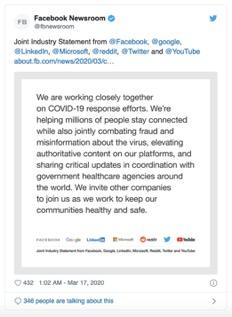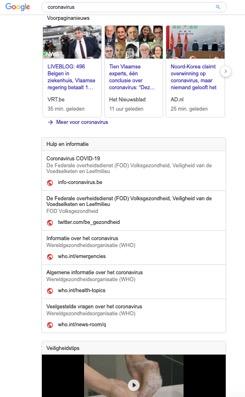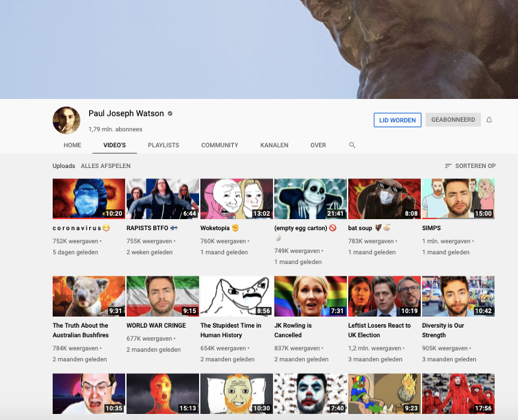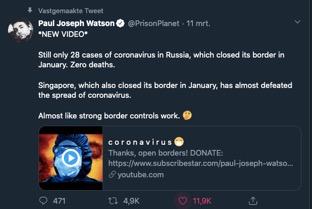
The coronavirus, the attention economy and far-right junk news
The coronavirus has devastating consequences for social life in all corners of the world. People are dying and country after country is forced to take drastic measures in the hope of flattening the curve. For others, this pandemic is an opportunity to reach a wide audience, to make money or to further a political agenda. Not surprisingly, the coronavirus crisis is heavily politicized by far-right YouTubers.
The coronavirus and the attention economy
The tired old slogan "never waste a good crisis" has taken on a new dimension in the digital era. Each crisis comes with new search terms and thus new ways in which all kinds of people and organizations try to get their agenda across. The format of "Breaking News" is of course not only an "informative format"; it has always been an intrinsic part of a commercialized media landscape. Concretely, it has always functioned as an opportunity for mainstream media to score: to draw in new readers or viewers and to establish themselves as important in the media field.
Breaking news generates similar opportunities in the digital media landscape. Governments, newspapers and activists, all use the digital infrastructure to inform people. Artists use digital platforms to bring art into people's quarantined life and public intellectuals and left-wing activists use the same infrastructure to highlight the class dimension of the crisis and the devastating impact of the crisis on asylum seekers.
At the same time, this infrastructure also provides an opportunity for people willing to monetize the crisis, for conspiracy thinkers and, of course, also for extreme-right activists, who exploit the public's eagerness to consume news to direct people to their medium. Especially in cases where breaking news focusses on a rare place or a rare disease for which not many qualitative search results are available, this opens opportunities to drive traffic. Such data voids, as Golebiewski and boyd (2018) call them, enable actors to optimize their content in order to score top rankings in the search engines of Google, YouTube and other platforms (Golebiewski & boyd, 2018). And even when there is no such data void, key terms associated with the breaking news still create an opportunity to drive traffic.

Joint Statement from major tech companies on Coronavirus
Considering the lives that are at stake during this pandemic, we see digital media companies taking precautions. Several major Western Tech companies – Google, Facebook, Twitter, Linkedin, YouTube and Reddit – declared that they would combat misinformation on the coronavirus (see image 1). On search engines like Google, which currently have more than enough qualitative news to show, we see that search results are highly structured (see image 2). When searching for information on the coronavirus, we see that Google prioritizes official government communication, showing safety tips and local mainstream media news.

Google query - Corona
The massive attention to and communication of mainstream media soucres', governments' and health institutions' information on the coronavirus has a double effect. On the one hand, it makes it more difficult to "stumble across" junk news. On the other hand, it creates a market for people actively searching for "alternative news" on the virus. Especially people distrusting governments and mainstream media - a public that has been carefully built up in recent years - see these interventions by mainstream digital media as censorship, proof of the Deep State's existence and even dictatorship. This narrative has shaped a large niche over the years, which far-right activists can exploit.
The pandemic has been carefully used by these political actors to drive traffic and exploit the public's attention.
Far-right activists, conspiracy thinkers, and right-wing political influencers have shown to be very skilled and media-literate (see for example Maly, 2019) not only in using breaking news for their political agenda, but also in optimizing their content and getting it ready for uptake (Maly, 2018). The coronavirus crisis is no exception. The pandemic has been carefully used by these political actors to drive traffic and exploit the public's attention; to politicize their audience. Counter-Currents, Stefan Molyneux, Nick Fuentes on his America First show, and InfoWars have all produced content on the coronavirus. In general, we can say that, for the far-right, the successful management of the coronacrisis is an exceptional case that prefigures their dream of a New World Order that replaces what they call "globalism".
Joseph Paul Watson, bat soup and globalism
One of the most successful far-right influencers and conspiracy theorists on YouTube is Joseph Paul Watson. 1.79 million people are subscribed to his channel and his videos easily manage to reach several hundred thousand viewers. One of the reasons for his success is his thorough understanding of search engine optimalisation in YouTube and the fact that he easily taps into hyped or popular items in the hybrid media system. From the Joker movie hype to the bush fires in Australia, Watson seems to have his say on each breaking news item in mainstream media and on YouTube.

Joseph Paul Watson's YouTube Channel - Video overview
Joseph Paul Watson is one of those YouTubers that use each heavily mediatized real-world event to further their political agenda. On 24 January 2020, Watson published his first video on the coronavirus titled "bat soup". Over 783,000 people have viewed this video so far and more than 16,000 people have commented on it. In the video, Watson manufactures a fearmongering bogus story mixing up facts and fiction. The scientific fact that the coronavirus was probably transmitted from bats to humans is simplified and reframed in a cultural othering narrative focusing on the so-called "habit of Chinese people" to eat "bat soup". The complex scientific reality of the transition of the virus from bats infecting other animals via their excrement or saliva is completely erased: the intermediaries transmitting the virus to humans are erased from the picture.

Still from Joseph Paul Watson's Bat Soup video
In Watson’s narrative, it is "the strange cultural habits of the Chinese" that are to blame for this pandemic crisis. The epidemic is re-entextualized in a by now overly familiar discourse attacking the so-called cultural relativism of the left and their moralizations as well as their framing of the right as bigots and racists. The video uses all affordances available to draw in a crowd: it is a short video with a thumbnail that features a scary bat wearing a face mask (indexing the coronavirus) along with the Chinese flag. Together with the title "bat soup" and the status "Eat the bat, bigot!", the video immediately sparks disgust and fear. Such sensational messages that bring new information, stir controversies and generate instant affective reactions – outrage in this case – perform very well in attention-based digital media like YouTube. Research shows that "Exaggerated, hyper-partisan stories are highly spreadable" (Mihailidis & Viotty, 2017). Watson is a master at this game.

Tweet from Joseph Paul Watson - 11 March - Coronavirus video
On 11 March, he posted a new video titled "c o r o n a v i r u s" accompanied by an emoji with a face mask and the status "Thanks, open borders!" More than 755,000 people viewed the video and it received 77,000 likes and more than 11,500 comments. This video focuses on the global nature of the coronavirus and immediately frames it in an existing anti-globalism discourse. The video makes one point: namely, that any success in the battle against the virus is based on a policy of closed borders. Watson praises Russia, Singapore, South Korea and Hong Kong for their swift action in closing their borders and connects this to their success in controlling the virus. All the other measures that these countries have been taking are completely erased. The coronavirus is used here to stress the deadly effects of globalism and highlight the benefits of closed borders.
Watson surfs the waves of breaking news by producing content that simplifies, twists and merges facts with fiction.
This video by Watson shows the complexity of so-called "fake news". Throughout the video, he uses several mainstream media sources to back his political agenda. Facts are isolated and re-entextualized in a political narrative. Venturini (2019: 126) therefore argues that we should understand this type of news not per se as "fake" news but as viral news or, better yet, "junk news". Concretely, he argues that we should focus more on "diffusion" than on "falsity".
Watson provides a good case for examining these arguments. Watson surfs the waves of breaking news by producing content that simplifies, twists and merges facts with fiction, specifically leaving out certain parts of the truth to make a "new", sensational video like the one in the last example in order to make a political point. He uses the affordances of the digital ecology to the fullest. The coronavirus video was not only posted on YouTube, but Watson also used Twitter (and, before his ban, also Facebook), where the video received almost 5,000 retweets. The success of his Twitter account is not only based on his content, but also on bots and the bot-like behavior of his followers. A scan of 2,000 of his followers in Botometer shows that around 20% of his followers are bots or display bot-like behavior. This type of algorithmic activism boosts interaction, and thus also reach in this attention-based economy.
Junk news, digital media and politics
The case of Jospeh Paul Watson shows how political activists can use media hypes and global crises to further their political agenda. Digital media, in this case YouTube, enables activists to reach a large audience by surfing the hype of the moment. A quick search on "bat soup corona" immediately shows the problem with junk news. It saturates the public debate, preventing more important stories from being heard (Venturini, 2019: 126).
The scale social media operate on makes controlling this junk news problem a complex affair. The joint statement issued by tech companies sounds promising, but the point here is that the problem of junk news is a fault of the system. All digital media monetize reach, engagement and even production of content by their users. Junk news is a product of this configuration of the digital ecology and it won’t be fixed with a technological patch.
And that is exactly what Big Tech companies rely on. They propose technological fixes for combatting this phenomenon of junk news. All too often, this battle against "fake news" focuses on a binary logic: something is "fake" or not. A producer is trustworthy or not. This type of evaluation is not only very hard to make, but it is even harder to program. In the worst cases, it leads to involuntary blocks or (shadow) banning of users, but in reality it often means that non-mainstream media have less reach but also that more subtle types of junk news still circulate.
Meanwhile, Watson’s posts are still visible on Twitter and on YouTube.
References
Golebiewski, M. and boyd, d. (2018). Data Voids: Where Missing Data Can Easily Be Exploited.Data & Society.
Maly, I. (2018). Nieuw Rechts. Berchem: Epo.
Maly, I. (2019). New Right Metapolitics and the Algorithmic Activism of Schild & Vrienden.Social Media + Society.
Mihailidis, P. & Viotty, S. (2017). Spreadable Spectacle in Digital Culture: Civic Expression, Fake News, and the Role of Media Literacies in “Post-Fact” Society. American Behavioral Scientist 61(4): 10.1177/0002764217701217
Venturini, T. (2019). From Fake to Junk News. The data politics of onine virality. in Bigo, D., Isin, E. & Ruppert, E. Data politics. Worlds, subjects, rights. Routledge.